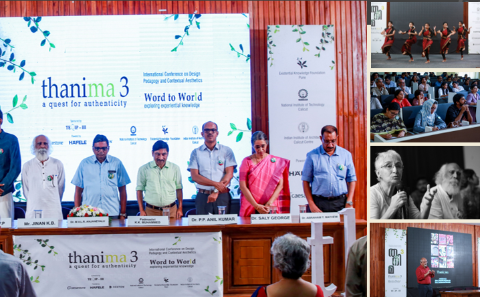Mar 06, 2020
Thanima 3
The visual experience of modern spaces worldwide is beginning to look alike. Until the last century, we have had diverse cultures with distinct ways of life and fitting aesthetic sensibilities. The homogenisation of human cultures is one of the biggest challenges of modernity to be addressed by both academia and practice. The real issue is to understand how aesthetic sensibilities as manifested by the things they make and the spaces they employ are inextricably linked to the cultural context.
The spirit of the conference is to engage in deep explorations and questions rather than ready answers and even when a solution is being offered, see the same with a spirit of openness. The objective of the conference is to explore various aspects of aesthetics - its formation, conditioning, politics, connection with culture and ways of teaching design pedagogy, the ambience for learning.
The reason for organizing the conference is to address the homogenization that is sweeping the world. The visual experience of modern spaces all over the world is beginning to look alike. In this regard, architecture and artefacts are no exceptions! Until last century, we have had diverse cultures with distinct ways of life and fitting aesthetic sensibilities. The homogenization of human cultures is one of the biggest challenges of modernity to be addressed by both academia and practice. The real issue is to understand how aesthetic sensibilities as manifested by the things they make and the spaces they employ are inextricably linked to the cultural context. It is the innate need of the system for its aesthetics to respond to cultural needs and nurture cultural diversity of local contexts.
Wellbeing and health of a culture depends on its authenticity and rootedness. The tangible- visible/ experiential- aspects of any culture is its aesthetic sensibility, which gets manifested in what and how people do.The buildings we make, the food we eat also when and how we eat, the language we use etc etc. In fact everything we do constitute our culture, even why and how. When people lose their authentic and original aesthetic sense, their culture gets destroyed.
The most important task we need to address is the homogenization of aesthetic sense. All aspects of our life are getting standardized and homogenized. This is no longer a cultural question but only a spiritual exploration. A key lesson we can learn from the non-literate people/ artisan communities is about the role of aesthetic sense in retaining cultural roots as they have been able to keep alive the diversity to a great extent whereas the educated have been totally homogenized. So what is in education that kills our aesthetic sensibility? What about art, architecture, design and fashion education, which is responsible for moulding and conditioning the taste of people? What is it in their education that totally distorts and homogenises their aesthetic sensibility and kills their moral/ ethical sensitivity?
The conference is designed to rethink the education of the aesthetic sense – involving both architecture and design.




